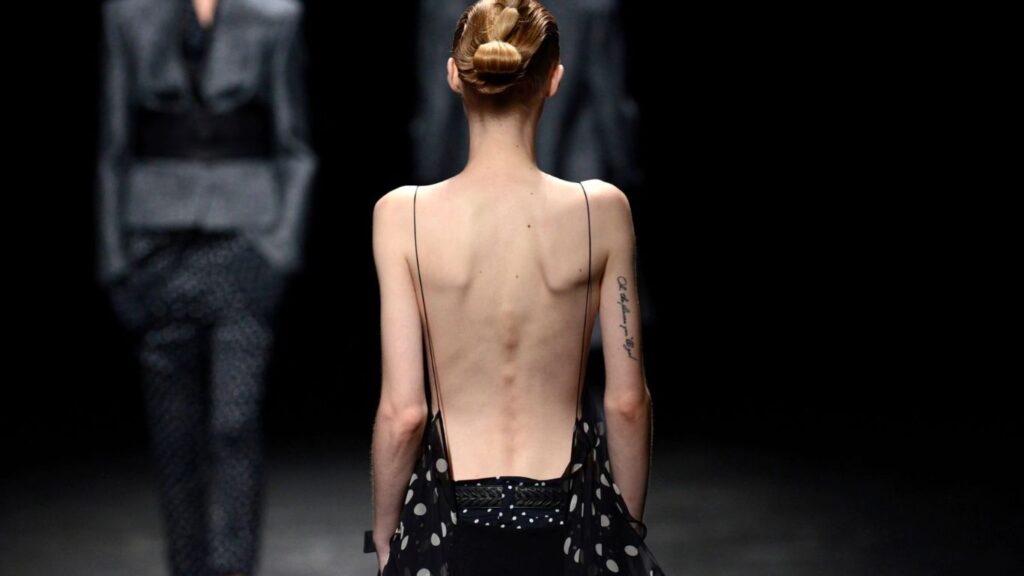Have you ever flipped through a glossy magazine or watched a high-fashion runway show and wondered, “Why are all the fashion models so skinny?” This curiosity isn’t just about aesthetic preferences or designer whims; it’s a deeply rooted phenomenon that spans history, culture, and the very fabric of the fashion industry. From the Renaissance, where plumpness was a status symbol, to today’s runway rulers, the slender ideal has evolved but consistently remained in vogue.
In this blog, we’re going to untangle the threads that have sewn this slender standard into the fashion world’s tapestry. We’ll explore the influence of designers, the power of media portrayals, and the shifting sands of cultural beauty standards. Join us as we delve into a narrative that’s about much more than just clothes—it’s about the bodies that wear them and the stories they tell.
Why Are Fashion Models Skinny?
Historical Context of Modeling Standards
From Curves to Couture
Once upon a time, the icons of beauty bore voluptuous figures that celebrated curves aplenty. Fast forward to the 20th century, and the pendulum of fashion swung dramatically. Enter the 1960s, the era of revolution not just in politics and culture but in fashion too. Twiggy, with her waif-like figure, redefined femininity, setting the stage for what was to come. As designers chased fresher, bolder expressions, the industry clung to this new ideal—thin was in, and it was here to stay.
Icons That Shaped the Skinny
Fashion’s blueprint was redrawn by influential figures who envisioned the runway as a canvas for artistic expression. Coco Chanel, the grande dame of style, championed simplicity and elegance that favored a slimmer physique, arguing it better showcased the clothes themselves. This philosophy was magnified by the theatrical demands of the runway, where dramatic silhouettes and avant-garde designs demanded a human hanger rather than a human being.
Influence of Fashion Designers
Designing Dreams
Why do designers prefer skinny models? It’s not just about aesthetics; it’s about the vision. In the high-stakes world of fashion, designers are artists who paint their visions on a living canvas. The skinny model has become a preferred choice because, in the eyes of many creators, less body means more room for the clothes to speak. The stark lines, the flow of a fabric, and the intricate details all come alive on a slender frame.
The Runway Effect
The impact of this preference doesn’t just ripple; it roars through the entire industry. When haute couture and high fashion set a trend, the world listens. The skinny standard seen on the runway soon seeps into retail, advertisements, and even into our closets. It’s a cycle fueled by visibility and desire—what we see on the catwalk, we often want to replicate.
The Role Of Media And Advertising
Picture Perfect
In our quest to decode why models are so skinny, the spotlight inevitably falls on the media. Fashion magazines, glossy ads, and billboards have long portrayed thinness as synonymous with beauty, success, and desirability. This portrayal isn’t just passive; it’s aggressive, shaping societal views and personal aspirations. The advent of digital media has intensified this effect, with photo retouching and filters creating unattainable ideals that further cement the skinny model as the gold standard.
The Rise of Influencers
With the digital age, a new runway has emerged—social media. Influencers wielding significant followings promote lifestyles and body images that often mirror the high fashion standards. As these influencers become brand ambassadors, the skinny ideal finds a new, powerful channel of dissemination, reaching more eyes than ever before.
Health And Industry Standards
The Cost of Couture
While the aesthetic of thinness dominates the runway, its toll on model health can be profound. The pressure to maintain a minimal body weight isn’t just daunting; it’s dangerous. Eating disorders and mental health issues are significantly higher among models, driven by relentless demands to fit into the size zero mold.
A Shift Towards Sustainability
Thankfully, the winds are changing. Recent years have seen a push for healthier models, driven by both legal measures and ethical considerations. Countries like France have led the charge, mandating health checks and minimum BMI requirements for working models. This movement is gaining momentum, challenging the industry to redefine beauty standards in healthier, more inclusive ways.
Economic Aspects
The Business of Being Skinny
The preference for skinny models isn’t merely a matter of taste—it’s deeply rooted in economics. Designers, modeling agencies, and advertisers all operate in a system that monetizes the skinny standard. Slimmer models often mean lower costs for fabric and sample productions, and the visual impact of these models on runways and campaigns drives sales and media buzz, which translates into profits.
The Price of Change
Embracing diversity and inclusivity involves not just changing aesthetics but also confronting economic realities. Brands and designers who advocate for change often face significant initial costs and market resistance. However, the growing demand for representation and authenticity is paving the way for a new business model that values diversity just as much as profitability.
Push Towards Diversity And Inclusivity
Breaking the Mold
The fashion industry is at a crossroads, faced with the growing demand for realism and representation. Spearheaded by trailblazers who dare to defy traditional norms, the push towards inclusivity is reshaping the runway. Brands like Fenty by Rihanna and designers such as Christian Siriano are leading the charge, showcasing models of all sizes, ethnicities, and backgrounds. Their success not only highlights the public’s appetite for diversity but also challenges the entrenched norms of the fashion industry.
The Ripple Effect
This shift towards inclusivity isn’t just about adding sizes; it’s about changing narratives. The impact is profound, affecting everything from modeling agency rosters to fashion marketing strategies. As inclusivity becomes a badge of honor, more brands are recognizing the value of diversity—not just as a moral imperative but as a business strategy that resonates with a broader audience.
Endnote
Reflecting on Beauty
As we’ve seen, the reasons behind why fashion models are skinny are complex and multifaceted, spanning historical influences, media portrayal, economic incentives, and health considerations. The evolution of this standard is slow but evident as the industry begins to embrace a broader definition of beauty that celebrates all forms.
Looking Forward
The future of fashion seems poised for change, driven by a new generation of designers, consumers, and activists who demand representation and respect for diversity. As we continue to challenge and expand the ideals of beauty, the hope is for a more inclusive and empathetic fashion world where every body type is celebrated.
We’d love to hear your thoughts! What changes do you hope to see in the fashion industry? Share your views in the comments below or on our social media channels. Let’s keep the conversation going and advocate for a fashion industry that truly dresses everyone.
Also Read : The Diverse Realms of Fashion Photography

